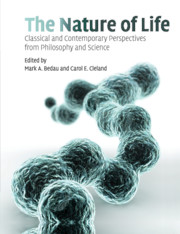Book contents
- Frontmatter
- Contents
- Preface
- Acknowledgments
- Sources
- About the authors
- Introduction
- SECTION I CLASSICAL DISCUSSIONS OF LIFE
- SECTION II THE ORIGIN AND EXTENT OF NATURAL LIFE
- 8 The origin of life: a review of facts and speculation
- 9 Small molecule interactions were central to the origin of life
- 10 Are the different hypotheses on the emergence of life as different as they seem?
- 11 The universal nature of biochemistry
- 12 Is there a common chemical model for life in the universe?
- 13 Searching for life in the universe: lessons from Earth
- 14 The possibility of alternative microbial life on Earth
- 15 Introduction to the limits of organic life in planetary systems
- SECTION III ARTIFICIAL LIFE AND SYNTHETIC BIOLOGY
- SECTION IV DEFINING AND EXPLAINING LIFE
- Supplementary bibliography on life
- Index
9 - Small molecule interactions were central to the origin of life
Published online by Cambridge University Press: 10 November 2010
- Frontmatter
- Contents
- Preface
- Acknowledgments
- Sources
- About the authors
- Introduction
- SECTION I CLASSICAL DISCUSSIONS OF LIFE
- SECTION II THE ORIGIN AND EXTENT OF NATURAL LIFE
- 8 The origin of life: a review of facts and speculation
- 9 Small molecule interactions were central to the origin of life
- 10 Are the different hypotheses on the emergence of life as different as they seem?
- 11 The universal nature of biochemistry
- 12 Is there a common chemical model for life in the universe?
- 13 Searching for life in the universe: lessons from Earth
- 14 The possibility of alternative microbial life on Earth
- 15 Introduction to the limits of organic life in planetary systems
- SECTION III ARTIFICIAL LIFE AND SYNTHETIC BIOLOGY
- SECTION IV DEFINING AND EXPLAINING LIFE
- Supplementary bibliography on life
- Index
Summary
A SIMPLER ORIGIN FOR LIFE
Extraordinary discoveries inspire extraordinary claims. Thus, James Watson reported that immediately after he and Francis Crick uncovered the structure of DNA, Crick “winged into the Eagle [pub] to tell everyone within hearing that we had discovered the secret of life.” Their structure—an elegant double helix—almost merited such enthusiasm. Its proportions permitted information storage in a language in which four chemicals, called bases, played the same role as 26 letters do in the English language.
Further, the information was stored in two long chains, each of which specified the contents of its partner. This arrangement suggested a mechanism for reproduction: The two strands of the DNA double helix parted company, and new DNA building blocks that carry the bases, called nucleotides, lined up along the separated strands and linked up. Two double helices now existed in place of one, each a replica of the original.
The Watson–Crick structure triggered an avalanche of discoveries about the way living cells function today. These insights also stimulated speculations about life's origins. Nobel laureate H. J. Muller wrote that the gene material was “living material, the present-day representative of the first life,” which Carl Sagan visualized as “a primitive free-living naked gene situated in a dilute solution of organic matter.” (In this context, “organic” specifies compounds containing bound carbon atoms, both those present in life and those playing no part in life.) Many different definitions of life have been proposed.
- Type
- Chapter
- Information
- The Nature of LifeClassical and Contemporary Perspectives from Philosophy and Science, pp. 129 - 136Publisher: Cambridge University PressPrint publication year: 2010



